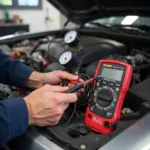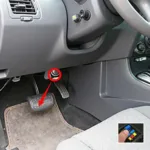Finding the OBD2 port in your 2017 Corolla can be surprisingly tricky if you’re not familiar with its usual hiding spots. This guide provides a detailed walkthrough, covering everything from the port’s standard location to troubleshooting tips and common questions.
Pinpointing the OBD2 Port in Your 2017 Toyota Corolla
The OBD2 (On-Board Diagnostics 2) port in a 2017 Toyota Corolla is typically located under the driver’s side dashboard, near the steering column. It’s a female, trapezoidal 16-pin connector, often covered by a small plastic panel. Knowing its exact location is crucial for accessing your car’s diagnostic data and troubleshooting any potential issues.
 2017 Corolla OBD2 Port Location Under Dashboard
2017 Corolla OBD2 Port Location Under Dashboard
Why is the OBD2 Port So Important?
The OBD2 port is the gateway to your car’s internal computer. It allows mechanics and car owners to access a wealth of information about the vehicle’s performance, emissions, and potential problems. Connecting a scanner to this port can reveal diagnostic trouble codes (DTCs), which pinpoint specific malfunctions, saving time and money on repairs. From checking engine health to monitoring fuel efficiency, the OBD2 port offers valuable insights into your Corolla’s overall condition.
Common Issues and Troubleshooting
Sometimes, locating the OBD2 port can be a little more challenging. It might be hidden behind a panel, tucked away in an awkward position, or even obstructed by other components.
- Can’t find the port? Double-check under the dashboard, along the edges of the center console, and even beneath the steering column. Consult your owner’s manual for a specific diagram if needed.
- Connector damaged? Inspect the pins for any bends or breaks. A damaged connector can prevent proper communication with your scanner.
- Scanner not connecting? Ensure your scanner is compatible with the 2017 Corolla and that the ignition is turned to the “on” position (but not started).
Utilizing the OBD2 Port: Beyond Diagnostics
The functionality of the OBD2 port extends beyond simple diagnostics. You can use it to:
- Monitor real-time data: Track engine performance, fuel economy, and other vital statistics.
- Customize vehicle settings: Adjust certain features and parameters, depending on your vehicle’s capabilities.
- Install aftermarket accessories: Integrate devices like remote starters and performance tuners.
“The OBD2 port has become an indispensable tool for both professionals and car enthusiasts. It empowers individuals to take control of their vehicle’s maintenance and understand its inner workings,” says Michael Davis, Senior Automotive Technician at Davis Auto Repair.
Beyond the Basics: Advanced OBD2 Applications
The OBD2 port is more than just a diagnostic tool; it’s a powerful interface that offers a range of advanced applications, including:
- Emission testing: Verify your vehicle’s compliance with environmental regulations.
- Performance tuning: Optimize engine performance and fuel efficiency.
- Data logging: Record driving data for analysis and improvement.
Conclusion: Mastering Your Corolla’s OBD2 Port
Locating and understanding the corolla 2017 obd2 location is fundamental for any car owner. This knowledge allows you to diagnose problems, monitor performance, and enhance your overall driving experience. With the insights provided in this guide, you’re well-equipped to utilize this powerful tool to its full potential.
FAQs
- What is the standard location of the OBD2 port in a 2017 Corolla? It’s usually under the driver’s side dashboard, near the steering column.
- What does OBD2 stand for? On-Board Diagnostics 2.
- Why can’t I find my OBD2 port? It may be hidden behind a panel or obstructed by other components. Check your owner’s manual.
- My scanner isn’t connecting, what should I do? Ensure your scanner is compatible and that the ignition is on.
- Can I use the OBD2 port for more than just diagnostics? Yes, you can use it for real-time data monitoring, customization, and aftermarket installations.
- What should the OBD2 port look like? It’s a female, 16-pin trapezoidal connector.
- Where can I find more information about OBD2 codes? OBDFree offers extensive resources and articles on OBD2 codes and diagnostics.
For further assistance, contact us via WhatsApp: +1(641)206-8880, Email: [email protected] or visit us at 789 Elm Street, San Francisco, CA 94102, USA. Our 24/7 customer support team is always ready to help.

